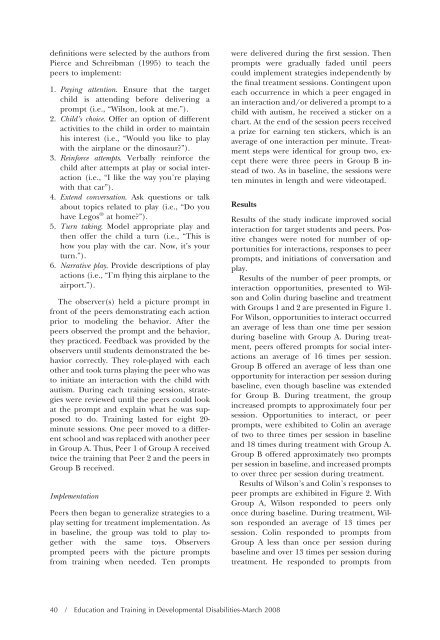Download the Journal (PDF) - Division on Autism and ...
Download the Journal (PDF) - Division on Autism and ...
Download the Journal (PDF) - Division on Autism and ...
Create successful ePaper yourself
Turn your PDF publications into a flip-book with our unique Google optimized e-Paper software.
definiti<strong>on</strong>s were selected by <str<strong>on</strong>g>the</str<strong>on</strong>g> authors from<br />
Pierce <strong>and</strong> Schreibman (1995) to teach <str<strong>on</strong>g>the</str<strong>on</strong>g><br />
peers to implement:<br />
1. Paying attenti<strong>on</strong>. Ensure that <str<strong>on</strong>g>the</str<strong>on</strong>g> target<br />
child is attending before delivering a<br />
prompt (i.e., “Wils<strong>on</strong>, look at me.”).<br />
2. Child’s choice. Offer an opti<strong>on</strong> of different<br />
activities to <str<strong>on</strong>g>the</str<strong>on</strong>g> child in order to maintain<br />
his interest (i.e., “Would you like to play<br />
with <str<strong>on</strong>g>the</str<strong>on</strong>g> airplane or <str<strong>on</strong>g>the</str<strong>on</strong>g> dinosaur?”).<br />
3. Reinforce attempts. Verbally reinforce <str<strong>on</strong>g>the</str<strong>on</strong>g><br />
child after attempts at play or social interacti<strong>on</strong><br />
(i.e., “I like <str<strong>on</strong>g>the</str<strong>on</strong>g> way you’re playing<br />
with that car”).<br />
4. Extend c<strong>on</strong>versati<strong>on</strong>. Ask questi<strong>on</strong>s or talk<br />
about topics related to play (i.e., “Do you<br />
have Legos ® at home?”).<br />
5. Turn taking. Model appropriate play <strong>and</strong><br />
<str<strong>on</strong>g>the</str<strong>on</strong>g>n offer <str<strong>on</strong>g>the</str<strong>on</strong>g> child a turn (i.e., “This is<br />
how you play with <str<strong>on</strong>g>the</str<strong>on</strong>g> car. Now, it’s your<br />
turn.”).<br />
6. Narrative play. Provide descripti<strong>on</strong>s of play<br />
acti<strong>on</strong>s (i.e., “I’m flying this airplane to <str<strong>on</strong>g>the</str<strong>on</strong>g><br />
airport.”).<br />
The observer(s) held a picture prompt in<br />
fr<strong>on</strong>t of <str<strong>on</strong>g>the</str<strong>on</strong>g> peers dem<strong>on</strong>strating each acti<strong>on</strong><br />
prior to modeling <str<strong>on</strong>g>the</str<strong>on</strong>g> behavior. After <str<strong>on</strong>g>the</str<strong>on</strong>g><br />
peers observed <str<strong>on</strong>g>the</str<strong>on</strong>g> prompt <strong>and</strong> <str<strong>on</strong>g>the</str<strong>on</strong>g> behavior,<br />
<str<strong>on</strong>g>the</str<strong>on</strong>g>y practiced. Feedback was provided by <str<strong>on</strong>g>the</str<strong>on</strong>g><br />
observers until students dem<strong>on</strong>strated <str<strong>on</strong>g>the</str<strong>on</strong>g> behavior<br />
correctly. They role-played with each<br />
o<str<strong>on</strong>g>the</str<strong>on</strong>g>r <strong>and</strong> took turns playing <str<strong>on</strong>g>the</str<strong>on</strong>g> peer who was<br />
to initiate an interacti<strong>on</strong> with <str<strong>on</strong>g>the</str<strong>on</strong>g> child with<br />
autism. During each training sessi<strong>on</strong>, strategies<br />
were reviewed until <str<strong>on</strong>g>the</str<strong>on</strong>g> peers could look<br />
at <str<strong>on</strong>g>the</str<strong>on</strong>g> prompt <strong>and</strong> explain what he was supposed<br />
to do. Training lasted for eight 20minute<br />
sessi<strong>on</strong>s. One peer moved to a different<br />
school <strong>and</strong> was replaced with ano<str<strong>on</strong>g>the</str<strong>on</strong>g>r peer<br />
in Group A. Thus, Peer 1 of Group A received<br />
twice <str<strong>on</strong>g>the</str<strong>on</strong>g> training that Peer 2 <strong>and</strong> <str<strong>on</strong>g>the</str<strong>on</strong>g> peers in<br />
Group B received.<br />
Implementati<strong>on</strong><br />
Peers <str<strong>on</strong>g>the</str<strong>on</strong>g>n began to generalize strategies to a<br />
play setting for treatment implementati<strong>on</strong>. As<br />
in baseline, <str<strong>on</strong>g>the</str<strong>on</strong>g> group was told to play toge<str<strong>on</strong>g>the</str<strong>on</strong>g>r<br />
with <str<strong>on</strong>g>the</str<strong>on</strong>g> same toys. Observers<br />
prompted peers with <str<strong>on</strong>g>the</str<strong>on</strong>g> picture prompts<br />
from training when needed. Ten prompts<br />
were delivered during <str<strong>on</strong>g>the</str<strong>on</strong>g> first sessi<strong>on</strong>. Then<br />
prompts were gradually faded until peers<br />
could implement strategies independently by<br />
<str<strong>on</strong>g>the</str<strong>on</strong>g> final treatment sessi<strong>on</strong>s. C<strong>on</strong>tingent up<strong>on</strong><br />
each occurrence in which a peer engaged in<br />
an interacti<strong>on</strong> <strong>and</strong>/or delivered a prompt to a<br />
child with autism, he received a sticker <strong>on</strong> a<br />
chart. At <str<strong>on</strong>g>the</str<strong>on</strong>g> end of <str<strong>on</strong>g>the</str<strong>on</strong>g> sessi<strong>on</strong> peers received<br />
a prize for earning ten stickers, which is an<br />
average of <strong>on</strong>e interacti<strong>on</strong> per minute. Treatment<br />
steps were identical for group two, except<br />
<str<strong>on</strong>g>the</str<strong>on</strong>g>re were three peers in Group B instead<br />
of two. As in baseline, <str<strong>on</strong>g>the</str<strong>on</strong>g> sessi<strong>on</strong>s were<br />
ten minutes in length <strong>and</strong> were videotaped.<br />
Results<br />
40 / Educati<strong>on</strong> <strong>and</strong> Training in Developmental Disabilities-March 2008<br />
Results of <str<strong>on</strong>g>the</str<strong>on</strong>g> study indicate improved social<br />
interacti<strong>on</strong> for target students <strong>and</strong> peers. Positive<br />
changes were noted for number of opportunities<br />
for interacti<strong>on</strong>s, resp<strong>on</strong>ses to peer<br />
prompts, <strong>and</strong> initiati<strong>on</strong>s of c<strong>on</strong>versati<strong>on</strong> <strong>and</strong><br />
play.<br />
Results of <str<strong>on</strong>g>the</str<strong>on</strong>g> number of peer prompts, or<br />
interacti<strong>on</strong> opportunities, presented to Wils<strong>on</strong><br />
<strong>and</strong> Colin during baseline <strong>and</strong> treatment<br />
with Groups 1 <strong>and</strong> 2 are presented in Figure 1.<br />
For Wils<strong>on</strong>, opportunities to interact occurred<br />
an average of less than <strong>on</strong>e time per sessi<strong>on</strong><br />
during baseline with Group A. During treatment,<br />
peers offered prompts for social interacti<strong>on</strong>s<br />
an average of 16 times per sessi<strong>on</strong>.<br />
Group B offered an average of less than <strong>on</strong>e<br />
opportunity for interacti<strong>on</strong> per sessi<strong>on</strong> during<br />
baseline, even though baseline was extended<br />
for Group B. During treatment, <str<strong>on</strong>g>the</str<strong>on</strong>g> group<br />
increased prompts to approximately four per<br />
sessi<strong>on</strong>. Opportunities to interact, or peer<br />
prompts, were exhibited to Colin an average<br />
of two to three times per sessi<strong>on</strong> in baseline<br />
<strong>and</strong> 18 times during treatment with Group A.<br />
Group B offered approximately two prompts<br />
per sessi<strong>on</strong> in baseline, <strong>and</strong> increased prompts<br />
to over three per sessi<strong>on</strong> during treatment.<br />
Results of Wils<strong>on</strong>’s <strong>and</strong> Colin’s resp<strong>on</strong>ses to<br />
peer prompts are exhibited in Figure 2. With<br />
Group A, Wils<strong>on</strong> resp<strong>on</strong>ded to peers <strong>on</strong>ly<br />
<strong>on</strong>ce during baseline. During treatment, Wils<strong>on</strong><br />
resp<strong>on</strong>ded an average of 13 times per<br />
sessi<strong>on</strong>. Colin resp<strong>on</strong>ded to prompts from<br />
Group A less than <strong>on</strong>ce per sessi<strong>on</strong> during<br />
baseline <strong>and</strong> over 13 times per sessi<strong>on</strong> during<br />
treatment. He resp<strong>on</strong>ded to prompts from
















